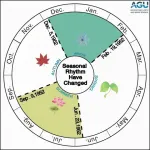(Press-News.org) American adults without a college degree have experienced greater reductions in life expectancy when compared to their more-educated counterparts, USC and Princeton researchers have found.
The study reveals that after nearly a century of declining mortality up to the late 1990s, the progress continued into the 21st century for more-educated Americans but stalled for the population as a whole and reversed for the two-thirds of Americans who do not have a college degree.
The study appeared Monday in the Proceedings of the National Academy of Sciences.
The researchers examined overall mortality in the United States using records spanning from 1990 to 2018. Assuming that mortality rates at each age remained constant at their level in each year, they then calculated how long a 25-year-old could expect to live up until the age of 75.
The age range (25-75 years old) coincides with increasing "deaths of despair" in the United States from the opioid epidemic, alcohol and suicide, as well as a slowing of progress on deaths from cardiovascular disease.
Study authors Anne Case and Sir Angus Deaton, who have previously documented the toll of deaths of despair on Americans, said their latest findings demonstrated the increasing influence of educational attainment on a person's health and economic security in the U.S.
"The United States has this increasingly sharp societal division between people who have a college degree and those who don't," said Deaton, Presidential Professor of Economics at the USC Dornsife College of Letters, Arts and Sciences, Distinguished Fellow at the USC Schaeffer Center and the Dwight D. Eisenhower Professor of International Affairs, Emeritus, at Princeton. "If you don't have a four-year degree, not only have your wages been falling for 50 years but our study shows your adult life expectancy is also decreasing."
"America is the richest large country in the world, with frontier medical technology, yet we still see large declines for Americans without a four-year degree, even prior to the arrival of COVID-19," said study author Anne Case, the Alexander Stewart 1886 Professor of Economics and Public Affairs, Emeritus, at Princeton University. "Without a four-year college diploma, it is increasingly difficult to build a meaningful and successful life in the United States."
The researchers found that although the adult life expectancy gap widened between those with and without a college degree, it narrowed based on race. By 2018, the adult life expectancy of Black Americans with a bachelor's degree -- who in the past had a lower adult life expectancy than whites without a degree -- was closer to whites with a college degree than to Black Americans without a degree. This is in stark contrast with the larger racial divides of the 1990s.
Analysis of death certificates shows link between education level and mortality
The study was based on death certificates in the National Vital Statistical System, which includes records of 48.9 million deaths of people aged 25 to 84 between 1990 and 2018 -- before the COVID-19 pandemic. The data indicate age, sex, race, ethnicity, education and year of death.
Case and Deaton constructed a time series with a summary of each year's mortality rates in adulthood from ages 25 to 75. Like life expectancy at birth, their measure is what's known as a "period measure," or a summary of mortality rates between ages 25 and 75 in a given year. To calculate mortality rates, they drew on population data from the American Community Survey and the Current Population Surveys.
When looking at race, regardless of education, the researchers found some nuances. Hispanics at age 25 were closer to living another 50 years than whites. In turn, whites were closer to living another 50 years than Blacks. Overall, Blacks and Hispanics made greater gains in life expectancy than whites. However, between 2010 and 2013, progress on life expectancy stopped for all races.
The researchers said that people with some college do better than those with only a high school degree. However, the gap is much wider between those with and without a four-year degree. According to the study, by 2018, American adults with a bachelor's degree could expect to live another 48.2 years out of a possible 50, compared with 45.1 years for those without a college degree.
Case and Deaton said in addition to deaths of despair, contributing factors to reduced life expectancy include obesity, smoking and cardiovascular disease, along with a shrinking pool of high-quality jobs.
"Good jobs have become increasingly rare for workers without a college diploma, many of whom have lost their jobs to globalization and automation and for whom the cost of employer-provided health care has increasingly priced them out of the high-quality labor market," said Deaton. "There has been a real loss of the pillars of working-class life, and it has contributed to this decline in adult life expectancy."
The study's data predate the devastating COVID-19 pandemic. Other studies -- including a recent study by USC and Princeton scientists -- have calculated pandemic-related life expectancy declines by race and ethnicity.
Case and Deaton predict the pandemic will only exacerbate the education divide in life expectancy. They point to the fact that those without a bachelor's degree are more likely to work in sectors where they may face a greater risk of exposure than those with college degrees who are more likely to be able to work at home.
In their book, Deaths of Despair and the Future of Capitalism, Case and Deaton documented the deaths of despair -- a devastating epidemic that preceded COVID-19, taking the lives of 158,000 Americans in 2018 and contributing to the first three-year drop in U.S. life expectancy since the Spanish flu. They explored the struggles that have primarily affected those without a college degree, which led them to suicide, alcoholism, drug overdoses and premature death.
INFORMATION:
The study was supported by the National Institute on Aging with support through a grant to the
National Bureau of Economic Research (award no. R01AG053396).
The authors will discuss their findings in an event on March 16th. Contact USC Media Relations for more details.
Malaria is the deadliest pathogen in human history. Nearly half the people on Earth are at risk of contracting the disease from the parasites that cause it. But humans aren't the only ones who can get these parasites--different forms are found in other animals, including birds. By studying the DNA of those strains, scientists can get a better picture of how malarial parasites live, which may give clues on how to stop the disease. In a new paper in PNAS, researchers analyzed blood samples of more than 1,000 species of birds from the Andes looking for malaria; they found that the strains of malaria present in a local area don't always neatly align with the types of birds living there.
"Traditionally, we thought that there's ...
(Boston)--Despite the positive advances that anti-human immunodeficiency virus (HIV) therapy, commonly called anti-retroviral therapy (ART) or highly active antiretroviral therapy (HAART), has had on the life expectancy of HIV-positive people, finding a cure for HIV or acquired immunodeficiency syndrome (AIDS) has remained elusive.
"One of the major challenges in curing HIV is that there is a persistent latent reservoir of virus that is not targeted by current antiretroviral treatments and is hidden from immune cells. When treatment is interrupted, this reservoir of the virus allows the HIV ...
Here is a link to a free Altmetric Report on this Research Output
Aging-US published "Hyperbaric oxygen therapy increases telomere length and decreases immunosenescence in isolated blood cells: a prospective trial" which reported that the aim of the current study was to evaluate whether hyperbaric oxygen therapy (HBOT) affects telomere length (TL) and senescent cell concentrations in a normal, non-pathological, aging adult population.
Thirty-five healthy independently living adults, aged 64 and older, were enrolled to receive 60 daily HBOT exposures.
Whole blood samples were collected at baseline, at the 30th and 60th session, and 1-2 weeks following the last HBOT session.
Telomeres length of T helper, T cytotoxic, natural killer and ...
CHAMPAIGN, Ill. -- Tiny fluorescent semiconductor dots, called quantum dots, are useful in a variety of health and electronic technologies but are made of toxic, expensive metals. Nontoxic and economic carbon-based dots are easy to produce, but they emit less light. A new study that uses ultrafast nanometric imaging found good and bad emitters among populations of carbon dots. This observation suggests that by selecting only super-emitters, carbon nanodots can be purified to replace toxic metal quantum dots in many applications, the researchers said.
The findings, published in the Proceedings of the National Academy of Sciences, ...
About one billion people worldwide are at risk for schistosomiasis -- a debilitating disease caused by parasitic worms that live in fresh water and in intermediate snail hosts. A new study finds that the transmission risk for schistosomiasis peaks when water warms to 21.7 degrees centigrade, and that the most effective interventions should include snail removal measures implemented when the temperature is below that risk threshold.
The Proceedings of the National Academy of Sciences published the results, led by Emory University, the University of South Florida and the ...
When it comes to microelectronics, there is one chemical element like no other: silicon, the workhorse of the transistor technology that drives our information society. The countless electronic devices we use in everyday life are a testament to how today very high volumes of silicon-based components can be produced at very low cost. It seems natural, then, to use silicon also in other areas where the properties of semiconductors -- as silicon is one -- are exploited technologically, and to explore ways to integrate different functionalities. Of particular interest in this ...
Determining how rapidly the universe is expanding is key to understanding our cosmic fate, but with more precise data has come a conundrum: Estimates based on measurements within our local universe don't agree with extrapolations from the era shortly after the Big Bang 13.8 billion years ago.
A new estimate of the local expansion rate -- the Hubble constant, or H0 (H-naught) -- reinforces that discrepancy.
Using a relatively new and potentially more precise technique for measuring cosmic distances, which employs the average stellar brightness within giant elliptical galaxies as a rung on the distance ladder, astronomers calculate a rate -- 73.3 kilometers per second per megaparsec, give or take 2.5 km/sec/Mpc -- that lies in the middle of three ...
Inflammation in the body has been linked to the intensity of tobacco smoking among people with HIV, according to a team of University of Massachusetts Amherst researchers.
Krishna Poudel, associate professor of community health education in the School of Public Health and Health Sciences, and colleagues reported positive linear relationships between intensity, duration and pack-years of smoking and inflammation in HIV-positive people. They believe it to be the first, more thorough examination of specific smoking-related variables with the levels of inflammation in this group, while also taking into account highly active antiretroviral therapy (HAART) and other important factors.
The study's findings ...
WASHINGTON--Without efforts to mitigate climate change, summers spanning nearly six months may become the new normal by 2100 in the Northern Hemisphere, according to a new study. The change would likely have far-reaching impacts on agriculture, human health and the environment, according to the study authors.
In the 1950s in the Northern Hemisphere, the four seasons arrived in a predictable and fairly even pattern. But climate change is now driving dramatic and irregular changes to the length and start dates of the seasons, which may become more extreme in the future under a business-as-usual climate scenario.
"Summers are getting longer and hotter while winters shorter and warmer ...
Nursing homes with the largest proportions of non-White residents experience 3.3 times more COVID-19 deaths than do nursing homes with the largest proportions of White residents, according to a new study from the University of Chicago. The paper, published in JAMA Network Open, suggests that these differences are likely due to nursing home size and the level of coronavirus spread in the local community, reinforcing the inseparability of long-term care facilities from society at large when it comes to bringing the COVID-19 pandemic to heel.
Since the start of the ...






